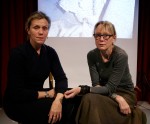From age 13 to 15, Suzanne Bocanegra wore a body cast to treat scoliosis, drastically altering her body from month to month, one day having a spine curvy like the figure of Marilyn Monroe, while another day having it retain the flat form of a little girl.
Bocanegra, an artist, tells this story in “Bodycast,” an artist lecture being performed today at the Hammer Museum and starring actress Frances McDormand, who takes on Bocanegra’s persona and describes the effect her body cast had on her development as an artist.
“I was being sculpted by my doctor,” Bocanegra said. “That time in my life when I had to wear a body cast greatly influenced my work and I wanted to tell that story.”
Bocanegra said she chose to channel her lecture through McDormand because she wanted to tell the story indirectly to emphasize her feelings of alienation during the time she wore the body cast. McDormand, approximately the same age and height as Bocanegra, acts as her doppelganger by mimicking her words for the audience to hear.
“I wanted to maintain the idea of sculpture since the body cast made me into a sculpture,” Bocanegra said. “McDormand is my sculpture that I want to animate.”
Director Paul Lazar said the fact that Bocanegra can be seen on stage reading lines to McDormand allows audiences to visually insert her into the story while she maintains her distance.
“Bocanegra’s writing lets the audience see the world from the detached view of somebody standing on the outside of society looking in, but still invariably integrated into it,” Lazar said.
Bocanegra said McDormand was perfect for the role because she delivers lines much better than Bocanegra could, using her extensive acting experience to easily connect with the audience. Engaging the audience with Bocanegra’s themes on artistic process is one of the lecture’s main goals, said technical manager Jamie McElhinney.
“Unlike many other artist lectures, viewers don’t need to previously know anything about Bocanegra,” McElhinney said. “Her work is meant not just to allow viewers to sit down and watch but to make decisions themselves about what they are seeing.”
The images Bocanegra presents to the audience are a series of personal photographs, art reproductions and film clips on topics ranging from scoliosis and a childhood in Texas to ballet and Titian paintings that influenced her development as an artist.
Of these topics, ballet was chosen as a discussion topic because she said it reflects specific ideas she developed about beauty when she practiced it during her body-cast period. Since ballet requires precision and agility to accomplish its complex movements, it demands physical excellence.
“I wanted to show how our bodies at that time of our lives teach women how to act and work,” Bocanegra said.
Lazar said “Bodycast” is also a deep meditation on how sociological factors influence artistic sensibility, referring to the effect Bocanegra’s childhood in Texas had on her aesthetic development. Since her hometown of Pasadena, Texas, had very conservative attitudes, she often came into conflict with her surroundings.
Bocanegra illustrates this conflict in her lecture as a visual collage, weaving together disparate images and incorporating them into the context of her life.
“‘Bodycast’ talks all over the place because there are a lot of different things that influenced me,” Bocanegra said. “I wanted to see where that takes me as an artist.”
